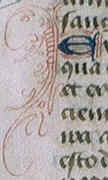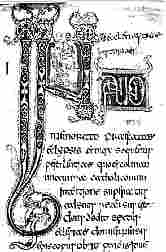 |
|
Initials
and Borders |
|
The
production of decorative initials and borders in manuscript
books became steadily more prolific as the middle ages progressed. Such
decorations undoubtedly added prestige to a volume and to some extent
can be seen as simply having been done for swank. They also have a function
in the reading of the text, just as a chapter heading does in a modern
book.
|
|
The
simplest, earliest and most persistent form of differentiated heading
was known as rubric,
the name deriving from the fact that it was executed in red. Rubrics were
used for headings for sections of text, serving as simple location markers.
In books of ritual such as the missal,
breviary or even
the book of hours,
rubrics were used to differentiate instructions, or markers of the progress
of the ritual, from the actual text being read or performed.
|
 |
|
Rubric
indicating a chapter heading in an 8th century collection of patristic
works (Cologne Cathedral Library, MS XCI). |
 |
|
The
rubric Post
co(mmunio) indicates the stage of the mass in a 12th century missal
(British Library, add ms 16949, f.iv), by permission of the British Library.
And yes, the photograph is black and white, but it is a rubric. |
 |
|
A
rubric indicates the stage of the ritual in a 15th century book of hours,
by permission of the University of Tasmania Library. |
|
In
the commercial production of books in the later middle ages, the rubricator
was a specialised position. As well as adding headings, they also sometimes
interpolated corrections to the text. In the later medieval period these
small headings, such as the chapter headings of the Bible,
were sometimes produced in other colours, notably blue. |
|
Decorative
initials and headings are regularly found in prestige works. As well as
adding social value to the volume, they also serve as placemarkers for
the text. Certain styles of decoration are diagnostic of time and place,
so that examination of these details can be used for sourcing and provenancing
works. |
|
|
Intricate
swirling and interlacing designs with beasties swallowing each other,
typical of Anglo-Saxon art, are found on this decorative initial on a
9th century copy of the works of Bede (British Library, Cotton Tiberius
CII, f.94), by permission of the British Library. |
 |
An
initial is surrounded by spidery and intricate late Gothic decoration
on a leaf from a late 15th century book of hours, by permission of the
University of Tasmania Library. |
| The
use of gold in initials and line fillers added to the prestige of a volume,
although it was common in even modest books of hours in the late medieval
period. Gold leaf
was rolled out immensely thin. The area to which it was to be applied was
built up with a layer of gesso, the gold leaf glued to it and carefully
burnished (with a beaver's tooth according to some traditions). The appearance
is of a thick, glowing mass of gold, but it is all an optical illusion.
Strictly, the term illumination
applies only to manuscripts decorated with gold in this way, as the pages
were regarded as glowing with their own light. |
 |
Gold
leaf applied to an initial and to a decorative line filler in a page from
a late 15th century French book of hours, by permission of the University
of Tasmania. |
 |
|
Large
decorative headings might serve to introduce a section of text and act
as a place marker, but sometimes it seems that the expectation was that
the text itself was well known and remembered, as decorative effects could
render legibility difficult. Some Anglo-Saxon and early Irish manuscripts
displayed headings that were like a puzzle or anagram. |
|
|
The
heading for Psalm 26 in the 8th century Vespasian Psalter (British Library,
Cotton Vespasian A1 f.31), by permission of the British Library. |
| The example above reads DNS (DOMINUS) INLUMINATIO MEA. The letters are entangled into a puzzle knot. |
|
continued  |
 Decoration Decoration |
|
|
|
|
|





